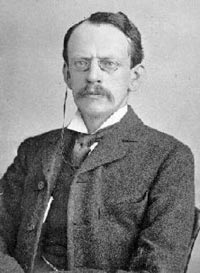
| Born: Dec 18, 1856 in Manchester, Lancashire, UK |
| Died: Aug 30, 1940 (at age 83) in Cambridge, UK |
| Nationality: British |
| Famous For: Plum pudding model, Discovery of electron, Discovery of isotopes, Mass spectrometer invention, First m/e measurement, Proposed first waveguide, Thomson scattering, Thomson problem, Coining term ‘delta ray’, Coining term ‘epsilon radiation’ and the Thomson (unit) |
| Awards: Nobel Prize for Physics (1906) |
J.J. Thomson was a brilliant British physicist who was born in Manchester, United Kingdom in December, 1856. He developed an interest in science from a very early age and showed remarkable talent as a pupil. He benefited from education in private schools, and was clever enough to be accepted into Owens College when he was only 14.
Upon leaving Owens College, he was accepted into Cambridge University in 1876, where he enrolled in Trinity College. He studied mathematics there, graduating with a first class honors BA in 1880. He had the second highest marks awarded in that year, and he was awarded the Smith’s Prize. He continued studying and received his MA degree in 1883, winning the Adam’s Prize.
Cavendish Laboratory
He was appointed Professor of Physics at the famous Cavendish Laboratory in Cambridge University in 1884. His skills as an inspirational teacher came to the fore, and during his time in charge, no less than seven of the staff under him won Nobel Prizes. Thomson himself would also win a Nobel Prize in 1906 for his discovery of the electron and his work on electrical conduction in gases. He lived to see his son also win a Nobel Prize in 1937.
Discovery of the Electron
Before Thomson’s discovery of the electron, physicists had long suspected that the atom was made up of smaller particles. However, the general belief was that the smallest components could not be any smaller than the hydrogen atom. In 1897, Thomson proposed that the atomic particles were up to 1,000 times smaller than the hydrogen atom.
He drew this conclusion as a result of his experiments with different types of rays. He devised an ingenious method to calculate the mass of rays under various influences and discovered their mass was significantly less than that of a hydrogen atom. Thomson’s breakthrough was to remove the air from the discharge tubes, thereby reducing the pressure. He also discovered that the mass remained constant regardless of what atom was used. He concluded from his research that an atom was composed of negatively charged particles. He called them corpuscles, but the scientific community preferred to call them electrons.
Mass Spectrometry
Thomson is credited with the invention of mass spectrometry. This is a method of deflecting rays using electrical and magnetic forces, and capturing the deflection on photographic plates. During experiments with neon gas, Thomson was able to show that there were two different deflection paths, meaning that neon was composed of two different atomic masses. In other words, there were two isotopes of neon. This was the first proof of isotopes existing in stable elements.
Honors
Apart from his Nobel Prize, Thomson received many honors. He was made a knight in 1908, and four years later was granted the Order of Merit, an award that had been introduced four years earlier to recognize distinguished service in a number of areas, including science. When he died in 1940, he was further honored by being buried in Westminster Abbey, alongside Isaac Newton and one of Thomson’s most brilliant former students, Ernest Rutherford.